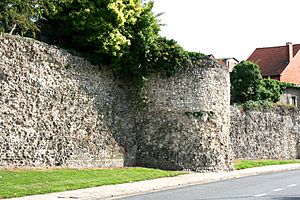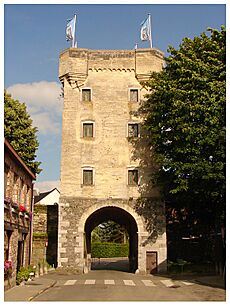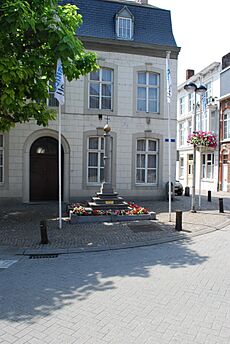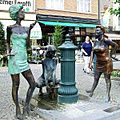Tongeren facts for kids
Quick facts for kids
Tongeren
|
|||
|---|---|---|---|
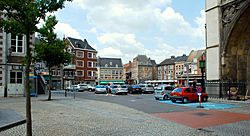
View of the Grote Markt
|
|||
|
|||
| Country | Belgium | ||
| Community | Flemish Community | ||
| Region | Flemish Region | ||
| Province | Limburg | ||
| Arrondissement | Tongeren | ||
| Area | |||
| • Total | 87.56 km2 (33.81 sq mi) | ||
| Population
(2018-01-01)Lua error in Module:Wd at line 1575: attempt to index field 'wikibase' (a nil value).
|
|||
| • Total | Lua error in Module:Wd at line 1,575: attempt to index field 'wikibase' (a nil value). | ||
| Postal codes |
3700
|
||
| Area codes | 012 | ||
| Website | www.tongeren.be | ||
Tongeren is a city and municipality in the Limburg province of Belgium. It's located in the southeastern part of the Flemish region. Tongeren is known as the oldest city in Belgium. It was once an important Roman capital. The Roman city was called Atuatuca Tungrorum. It was the main center for the Civitas Tungrorum district, where the Tungri people lived.
Contents
History of Tongeren
Tongeren in Roman Times
The Romans called Tongeren Aduatuca Tungrorum. It was the capital of a large Roman province called Civitas Tungrorum. This area covered what is now Belgian Limburg and parts of nearby regions. Before the Romans arrived, the Eburones tribe lived here. They were a group of Belgic tribes known as the Germani cisrhenani.
Some historians believe that Tongeren was the "Aduatuca" fort mentioned by Julius Caesar. Caesar wrote about the Eburones tribe revolting against him in 54 BC. They destroyed a Roman army group. Caesar reported that he defeated the Eburones. He invited other tribes, like the Sigambri, to plunder the area.
Later, the Tungri tribe became important in this area. They gave Tongeren its modern name. Roman Tongeren grew quickly. It was on an important road connecting Cologne to Bavay. The city was damaged by a big fire in 70 AD during the Batavian revolt. In the second century, a defensive wall was built around the city. Parts of this wall can still be seen today.
In 358 AD, the future emperor Julian met with Salian Franks in Tongeren. They had settled north of the city. Julian later surprised them with an attack, and they became part of his forces.
Tongeren in the Middle Ages
Around the fourth century, Tongeren became a center for Christianity. Saint Servatius, a bishop of Tongeren, died in 384 AD. The main church for the area later moved to nearby Maastricht and then to Liège.
During the Merovingian period (5th to 8th centuries), Tongeren lost some importance. However, a new church was built in Carolingian times. This is where the Basilica stands today. The building of the current basilica started in the 1200s in the Gothic style.
In the 13th century, a new medieval defensive wall was built. Many new churches, cloisters, and a Béguinage were also added. Tongeren became one of the "bonnes villes" (good cities) of the Prince-Bishopric of Liège. This meant it had special rights and importance.
Tongeren from the 1600s to Today
In 1677, most of Tongeren was burned down by the troops of Louis XIV. The city took a long time to recover from this disaster. It started to grow again after 1830.
In 1977, several smaller towns merged with Tongeren. Today, Tongeren is the main legal center for the Limburg province in Belgium.
Main Sights in Tongeren
Tongeren has many interesting historical places to visit:
- The Béguinage: Founded in 1257, this historic community for religious women is a UNESCO World Heritage Site. It survived the 1677 fire.
- The Basilica of Our Lady: This large church was built in the Gothic style starting in the 13th century. It has a tall, 64-meter Gothic tower. Inside, you can see the statue of Our Lady of Tongeren. The church's treasury holds a rich collection of religious art. Its bell tower is also a UNESCO World Heritage Site.
- Church of St. Catherine: Built in 1294, this Gothic church has beautiful artworks.
- The Gallo-Roman Museum: This museum shows many ancient objects found in the area. These include Celtic gold, Roman glass, and a mysterious Roman dodecahedron.
- The Roman wall: You can still see more than 1,500 meters of the original Roman wall from the second century.
- Medieval defensive towers: Some of these towers from the medieval city wall are still standing.
- Statue of Ambiorix: This statue was put up in 1866 to honor the ancient Eburones leader.
- Tumuli: These are ancient burial mounds found around the city.
- Pliniuspark: This park has the Plinius spring, a natural spring mentioned by the Roman writer Pliny the Elder.
- Teseum-museum: Located partly under the Basilica, this museum shows archaeological finds from the church's site and explains its history.
Events in Tongeren
- The Kroningsfeesten ("Coronation Celebrations"): These big religious parades happen every seven years. They celebrate the crowning of a special statue of the Blessed Virgin Mary. It's one of the largest and most impressive processions in Belgium.
- Antiques Fair: A popular antiques fair takes place every Sunday. It's the biggest of its kind in the Benelux region (Belgium, Netherlands, Luxembourg).
Sports in Tongeren
- Datovoc Tongeren: This women's volleyball club plays in the top Belgian league.
- K.S.K. Tongeren: This is Tongeren's most famous football club.
Famous People from Tongeren
Ancient Times
- Ambiorix: A prince of the Eburones tribe and a leader who fought against the Romans. His statue is in Tongeren's main square.
- Saint Servatius: A bishop of Tongeren who helped bring Christianity to the Netherlands.
- Saint Helier: An ascetic hermit and the patron saint of Jersey.
Modern Times
- Robert Cailliau: He helped invent the World Wide Web along with Tim Berners-Lee.
- Patrick Dewael: A politician who was a former Minister President of Flanders and is the current mayor of Tongeren.
- Freddy Loix: A famous rally car driver.
Images for kids
-
The Dodecahedron
See also
 In Spanish: Tongeren para niños
In Spanish: Tongeren para niños





